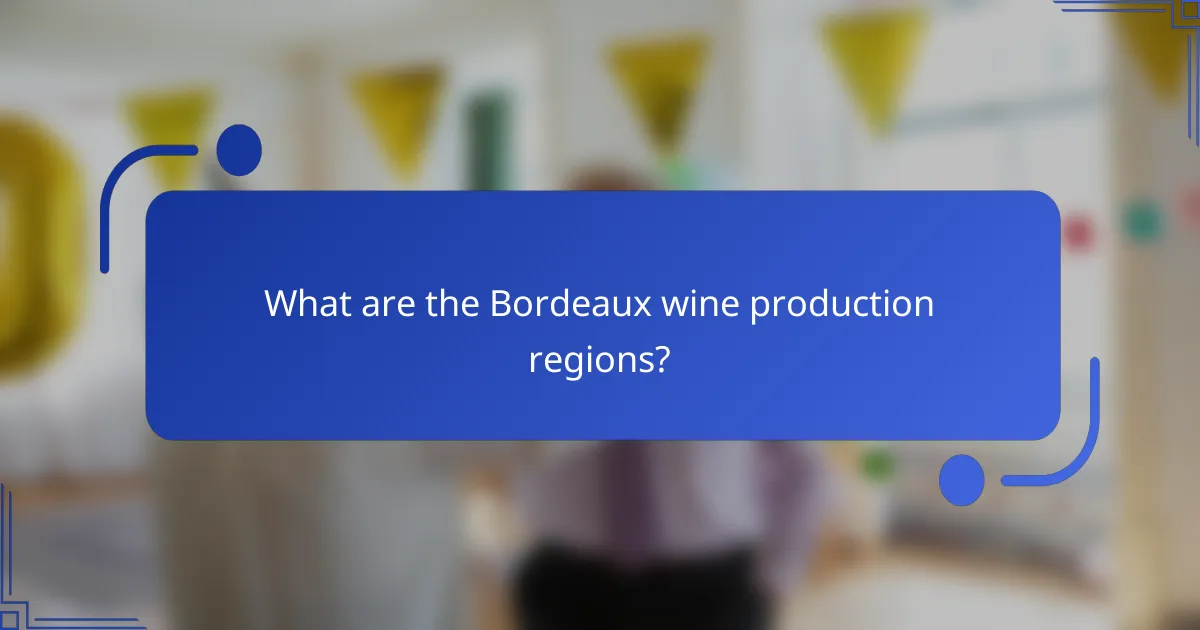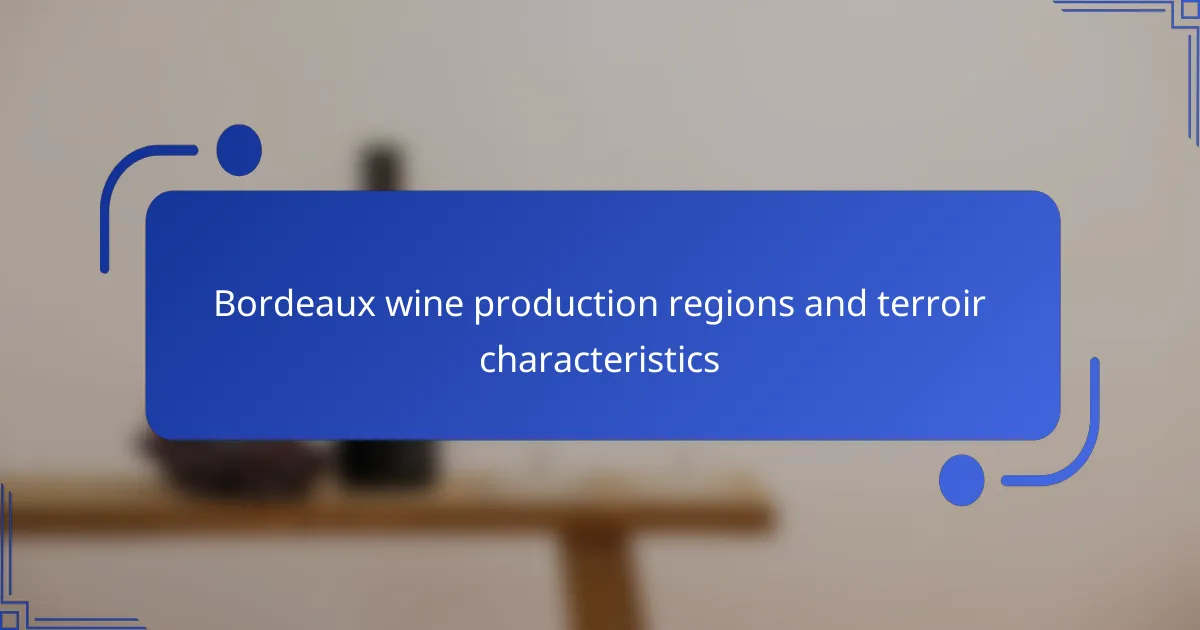
What are the Bordeaux wine production regions?
Bordeaux wine production regions include the Médoc, Saint-Émilion, Pomerol, Graves, and Sauternes. The Médoc is known for its Cabernet Sauvignon-based wines. Saint-Émilion produces Merlot-dominant blends. Pomerol is famous for its high-quality Merlot wines. Graves is recognized for both red and white wines. Sauternes is renowned for its sweet dessert wines. Each region has distinct terroir characteristics that influence the wine’s flavor and quality.
How are the Bordeaux wine regions categorized?
Bordeaux wine regions are categorized primarily into six main sub-regions. These sub-regions are Médoc, Haut-Médoc, Graves, Saint-Émilion, Pomerol, and Sauternes. Each sub-region has distinct terroir characteristics that influence the style and quality of the wines produced. The Médoc is known for its Cabernet Sauvignon-dominant blends. Haut-Médoc includes prestigious appellations like Margaux and Pauillac. Graves is recognized for both red and white wines, particularly Sauvignon Blanc. Saint-Émilion is famed for its Merlot-based wines. Pomerol produces high-quality Merlot wines, while Sauternes is celebrated for its sweet dessert wines. This categorization is essential for understanding the diversity and quality of Bordeaux wines.
What are the main geographical divisions within Bordeaux?
The main geographical divisions within Bordeaux are the Left Bank, Right Bank, and Entre-Deux-Mers. The Left Bank includes notable areas like Médoc and Graves. The Right Bank is known for regions such as Saint-Émilion and Pomerol. Entre-Deux-Mers lies between the Garonne and Dordogne rivers. Each division has distinct terroirs that influence wine characteristics. The Left Bank is predominantly Cabernet Sauvignon, while the Right Bank favors Merlot. Bordeaux’s classification system further delineates these regions based on historical and quality criteria. This structure underpins the wine production hierarchy in Bordeaux.
How do these divisions affect wine production?
Divisions in Bordeaux wine regions significantly affect wine production. Each division, such as Médoc, Saint-Émilion, and Pomerol, has distinct terroir attributes. Terroir includes soil composition, climate, and topography. These factors influence grape variety selection and growing conditions. For example, Cabernet Sauvignon thrives in the gravelly soils of Médoc. In contrast, Merlot is more suited to the clay soils of Saint-Émilion. Additionally, climate variations impact ripening and flavor development. The specific regulations and classifications, like AOC, further dictate production methods and quality standards. This structured approach ensures that wines reflect their unique regional characteristics. Ultimately, these divisions create a diverse array of wine styles and qualities in Bordeaux.
What are the key characteristics of each Bordeaux region?
Bordeaux wine production regions are characterized by distinct terroirs and grape varieties. The Left Bank includes regions like Médoc and Graves, known for Cabernet Sauvignon dominance. This area has gravelly soils that enhance drainage and heat retention. The Right Bank features regions such as Saint-Émilion and Pomerol, which favor Merlot and Cabernet Franc. The clay and limestone soils here contribute to softer, fruitier wines. The Entre-Deux-Mers region is located between the Garonne and Dordogne rivers. It is recognized for its white wines, primarily Sauvignon Blanc and Sémillon. Each Bordeaux region’s climate also influences wine characteristics. The overall maritime climate ensures moderate temperatures and ample rainfall. These factors collectively shape the unique profiles of Bordeaux wines.
What makes the Médoc region unique?
The Médoc region is unique due to its prestigious wine production and specific terroir characteristics. It is renowned for producing some of the world’s finest red wines, particularly Cabernet Sauvignon. The region’s gravelly soil enhances drainage and contributes to the complexity of the wines. Its maritime climate, influenced by the nearby Atlantic Ocean, provides ideal growing conditions. The Médoc is home to several classified growth vineyards, including Château Lafite Rothschild and Château Margaux. These vineyards have a rich history and are recognized for their exceptional quality. The unique blend of soil, climate, and tradition distinguishes the Médoc from other wine regions.
How does the Right Bank differ from the Left Bank?
The Right Bank and Left Bank of Bordeaux differ primarily in their grape varieties and wine styles. The Right Bank focuses on Merlot and Cabernet Franc, producing softer, fruitier wines. In contrast, the Left Bank emphasizes Cabernet Sauvignon, leading to bolder, tannic wines. The geographical layout also plays a role. The Right Bank is characterized by clay and limestone soils, which favor Merlot cultivation. The Left Bank features gravelly soils, ideal for Cabernet Sauvignon. Notable appellations include Saint-Émilion and Pomerol on the Right Bank, while the Left Bank is home to Médoc and Graves. This distinction influences the overall flavor profiles and aging potential of the wines produced in each region.
What historical factors have shaped Bordeaux wine regions?
Bordeaux wine regions have been shaped by several historical factors. Roman occupation introduced viticulture to the area around the 1st century AD. The establishment of trade routes during the Middle Ages facilitated the export of Bordeaux wines. The 17th century saw the rise of the Bordeaux wine market, particularly with the British demand for claret. The 1855 Classification ranked Bordeaux wines and solidified their reputation. Phylloxera outbreaks in the late 19th century led to significant changes in vineyard practices. The 20th century brought technological advancements in winemaking. Each of these factors contributed to the unique terroir and identity of Bordeaux wines.
How did historical events influence vineyard locations?
Historical events significantly influenced vineyard locations in Bordeaux. The establishment of trade routes during the Roman Empire facilitated the spread of viticulture. The 12th century marriage between Eleanor of Aquitaine and Henry II of England increased demand for Bordeaux wines. The Hundred Years’ War caused disruptions, leading to shifts in vineyard ownership and management. The phylloxera epidemic in the 19th century forced replanting with resistant rootstocks, altering vineyard layouts. Lastly, the classification of Bordeaux wines in 1855 established prestigious châteaux, impacting vineyard location decisions. Each of these events shaped the current landscape of Bordeaux vineyards.
What role did trade play in the development of Bordeaux regions?
Trade was essential in the development of Bordeaux regions. It facilitated the exchange of wine, boosting local economies. Bordeaux’s geographical location made it a strategic port for maritime trade. In the 18th century, Bordeaux became a key export hub for wine, particularly to England. This trade led to the establishment of vineyards and wineries to meet growing demand. The influx of wealth from trade improved infrastructure and local services. Trade relationships also introduced new winemaking techniques and grape varieties. Consequently, Bordeaux evolved into a renowned wine-producing region, shaping its identity and global reputation.

What is terroir and how does it relate to Bordeaux wines?
Terroir refers to the unique combination of environmental factors that affect the characteristics of a wine. This includes soil composition, climate, topography, and local traditions. In Bordeaux, terroir significantly influences the flavor and quality of its wines. The region’s diverse terroirs contribute to the distinct profiles of its various appellations. For instance, the gravelly soils of the Médoc enhance Cabernet Sauvignon’s structure. The clay-limestone soils of Saint-Émilion favor Merlot’s fruitiness. Bordeaux’s maritime climate also plays a crucial role in grape ripening and acidity levels. Understanding terroir is essential for appreciating the complexity of Bordeaux wines.
What are the components of terroir in Bordeaux?
The components of terroir in Bordeaux include climate, soil, topography, and grape variety. Climate influences the growing season and grape ripening. Bordeaux has a maritime climate, characterized by mild winters and warm summers. Soil types vary, including gravel, clay, and limestone, each affecting drainage and nutrient availability. Topography impacts sun exposure and drainage patterns. Different grape varieties, such as Merlot and Cabernet Sauvignon, thrive in specific terroirs, contributing to the region’s wine diversity. The interplay of these components shapes the unique characteristics of Bordeaux wines.
How does soil composition impact Bordeaux wine flavors?
Soil composition significantly impacts Bordeaux wine flavors. The region’s diverse soils, including gravel, clay, and limestone, influence grape characteristics. Gravel provides excellent drainage and reflects heat, enhancing ripeness and fruit flavors. Clay retains moisture and nutrients, contributing to the wine’s body and structure. Limestone imparts minerality and acidity, balancing sweetness. Studies show that specific soil types correlate with distinct flavor profiles in Bordeaux wines. For example, Merlot thrives in clay soils, producing softer, fruitier wines, while Cabernet Sauvignon prefers gravel, yielding more tannic and structured wines.
What climate factors are crucial for Bordeaux terroir?
Bordeaux terroir is significantly influenced by several climate factors. These include temperature, rainfall, humidity, and sunlight. The region experiences a temperate maritime climate, which is crucial for grape growing. Average temperatures range from 10°C in winter to 25°C in summer. Rainfall is distributed throughout the year, averaging around 800 mm annually. This balance of moisture is essential for vine health. Humidity levels are moderate, aiding in the development of complex flavors in grapes. Additionally, the region benefits from ample sunlight, which aids in the ripening process. These climate factors collectively contribute to the unique characteristics of Bordeaux wines.
Why is terroir important in wine production?
Terroir is crucial in wine production because it encompasses the unique environmental conditions affecting grape growth. This includes soil type, climate, and topography. These factors influence the flavor, aroma, and overall quality of the wine. For instance, Bordeaux wines are known for their distinct characteristics derived from the region’s specific terroir. Studies show that variations in terroir can lead to significant differences in wine profiles. The interaction between grapevines and their environment shapes the final product. Ultimately, terroir contributes to the uniqueness and identity of wines from different regions.
How does terroir affect wine quality and character?
Terroir significantly influences wine quality and character. Terroir encompasses the unique environmental conditions of a vineyard. These conditions include soil type, climate, and topography. Each element contributes to the grapes’ growth and development. For instance, well-drained soils enhance root depth and nutrient uptake. Climate affects ripening periods and sugar levels in grapes. Topography influences sunlight exposure and temperature variations. Research shows that Bordeaux wines exhibit distinct characteristics based on their terroir. Wines from gravelly soils often have a different flavor profile compared to those from clay soils. Thus, terroir plays a crucial role in defining the quality and character of Bordeaux wines.
What are the implications of terroir for winemakers?
Terroir significantly influences winemakers by shaping the characteristics of the wine produced. The term refers to the unique combination of soil, climate, and topography in a specific region. In Bordeaux, for instance, the terroir affects grape variety selection and ripening conditions. Different soil types, like gravel or clay, contribute to the flavor profile of the wine. Winemakers must adapt their techniques based on these terroir characteristics. This includes decisions on irrigation, harvest timing, and fermentation methods. The distinctiveness of terroir can enhance a wine’s marketability and identity. Studies show that wines reflecting their terroir are often perceived as higher quality by consumers. Therefore, understanding terroir is essential for winemakers aiming to produce exceptional wines.
How do different Bordeaux regions express their terroir?
Different Bordeaux regions express their terroir through unique combinations of climate, soil, and grape varieties. Each sub-region, such as Médoc, Saint-Émilion, and Pomerol, showcases distinct environmental conditions. The Médoc region benefits from gravelly soils that enhance Cabernet Sauvignon’s characteristics. In contrast, Saint-Émilion’s clay and limestone soils favor Merlot, producing softer, fruitier wines. Pomerol’s unique terroir, characterized by a mix of clay and iron-rich soils, contributes to the region’s renowned Merlot-based wines. Additionally, microclimates within these regions influence ripening patterns and flavor profiles. Historical practices, such as traditional vineyard management techniques, further enhance the expression of terroir in Bordeaux wines.
What are the flavor profiles associated with various Bordeaux terroirs?
Bordeaux terroirs exhibit distinct flavor profiles influenced by their unique characteristics. The Left Bank, particularly in Médoc, is known for full-bodied wines with notes of blackcurrant, cedar, and tobacco. The gravelly soils contribute to these robust flavors. In contrast, the Right Bank, especially in Saint-Émilion, typically produces softer wines with plum, cherry, and chocolate notes. The clay-rich soils enhance the fruitiness. The Entre-Deux-Mers region is recognized for its crisp white wines, often featuring citrus and herbal flavors due to the limestone and clay soils. Each terroir’s specific soil composition, climate, and grape varieties significantly shape these flavor profiles.
How do vineyard practices enhance terroir expression?
Vineyard practices enhance terroir expression by optimizing the conditions for grape growth. Practices such as soil management influence nutrient availability and drainage. Pruning techniques shape vine structure and fruit exposure to sunlight. Cover cropping improves soil health and biodiversity. Irrigation management ensures appropriate water supply, affecting vine stress levels. Sustainable farming practices reduce chemical inputs, promoting ecological balance. These factors contribute to the unique characteristics of Bordeaux wines, reflecting their specific terroir. Studies show that these practices can lead to improved flavor profiles and complexity in the final wine product.

What are the best practices for understanding Bordeaux wine production?
The best practices for understanding Bordeaux wine production include studying the region’s terroir, grape varieties, and winemaking techniques. Bordeaux’s terroir is characterized by its unique combination of soil types, climate, and topography. Key grape varieties include Cabernet Sauvignon, Merlot, and Cabernet Franc, each contributing distinct flavors. Familiarizing oneself with the classification system, such as the 1855 Classification, helps in understanding quality tiers. Visiting vineyards and tasting wines enhances practical knowledge. Engaging with local wine experts can provide deeper insights into production methods. Additionally, reading reputable wine literature and guides can further enrich understanding. These practices collectively build a comprehensive view of Bordeaux wine production.
How can consumers identify quality Bordeaux wines?
Consumers can identify quality Bordeaux wines by examining several key attributes. First, look for the wine’s classification. Bordeaux wines are often classified as Grand Cru, Cru Bourgeois, or AOC. These classifications indicate quality levels. Second, check the vintage year. High-quality Bordeaux wines typically come from exceptional harvest years. Third, assess the wine’s region of origin. Notable regions include Médoc, Saint-Émilion, and Pomerol. Each region has distinct terroir characteristics that influence wine quality. Fourth, consider the producer’s reputation. Renowned producers often maintain high quality. Finally, review tasting notes and ratings from wine critics. These provide insights into the wine’s flavor profile and overall quality. Quality Bordeaux wines often exhibit complexity, balance, and aging potential.
What labeling information should consumers look for?
Consumers should look for the Appellation d’Origine Contrôlée (AOC) on Bordeaux wine labels. The AOC indicates the specific region where the wine was produced. It guarantees adherence to strict production standards. Additionally, consumers should check the vintage year. The vintage provides information about the grape harvest. The grape variety is also essential; it indicates the primary grapes used. Alcohol content is another key detail; it informs about the wine’s strength. Look for the producer’s name for authenticity. Lastly, consumers should note any certifications, such as organic or biodynamic, that may be present. These labeling elements help ensure quality and origin in Bordeaux wines.
How does vintage impact the quality of Bordeaux wines?
Vintage significantly impacts the quality of Bordeaux wines. Each vintage reflects the climatic conditions during the growing season. Factors such as temperature, rainfall, and sunlight influence grape ripeness and flavor development. For instance, the exceptional 2010 vintage is often praised for its balance and concentration. Conversely, the 2013 vintage faced challenges with excessive rain, leading to diluted flavors. Historical data shows that top vintages consistently yield higher ratings from critics and better aging potential. Overall, the vintage serves as a crucial indicator of quality in Bordeaux wines.
What tips can enhance the Bordeaux wine tasting experience?
To enhance the Bordeaux wine tasting experience, focus on the proper environment and preparation. Begin by selecting a quiet and comfortable location. This allows for better concentration on the wine’s flavors. Use appropriate glassware to enhance aroma and taste. Bordeaux wines benefit from wide bowls that allow for aeration. Serve wines at the right temperature; reds should be slightly below room temperature, around 60-65°F. Pay attention to the wine’s visual aspects, such as color and clarity. Swirl the wine gently to release its aromas before inhaling deeply. Take small sips to fully appreciate the flavors and complexity. Note the wine’s finish, as Bordeaux wines often have a long aftertaste.
How should Bordeaux wines be served and paired with food?
Bordeaux wines should be served at specific temperatures and paired with suitable foods for optimal enjoyment. Red Bordeaux wines are best served slightly below room temperature, around 60-65°F (15-18°C). White Bordeaux wines are best served chilled, at about 45-50°F (7-10°C).
For food pairing, red Bordeaux complements rich dishes like beef, lamb, and game. The tannins in red Bordeaux enhance the flavors of these meats. White Bordeaux pairs well with seafood and poultry, balancing the dish’s flavors with its acidity.
These serving temperatures and pairings are based on traditional practices that enhance the wine’s characteristics and the dining experience.
What are common misconceptions about Bordeaux wines?
Common misconceptions about Bordeaux wines include the belief that all Bordeaux wines are expensive. While some prestigious Bordeaux wines can be costly, many affordable options exist. Another misconception is that Bordeaux wines are only red. Bordeaux produces high-quality white and rosé wines as well. Many people also think Bordeaux wines must be aged for years. Some Bordeaux wines are crafted for early consumption. Additionally, there is a notion that Bordeaux wines are solely Cabernet Sauvignon and Merlot. Bordeaux blends often include other varietals like Cabernet Franc and Petit Verdot. Lastly, many assume that Bordeaux wines are too tannic for casual drinking. Many Bordeaux wines offer a balance that can be enjoyed young.
Bordeaux wine production regions encompass distinct areas such as Médoc, Saint-Émilion, Pomerol, Graves, and Sauternes, each characterized by unique terroir attributes that influence the flavor and quality of the wines. The regions are categorized into Left Bank and Right Bank divisions, with specific grape varieties like Cabernet Sauvignon and Merlot thriving in their respective soils. Historical factors and trade have shaped vineyard locations and practices, while understanding terroir is crucial for appreciating the complexity and quality of Bordeaux wines. The article will detail the geographical divisions, key characteristics of each region, and best practices for consumers to identify quality Bordeaux wines.
